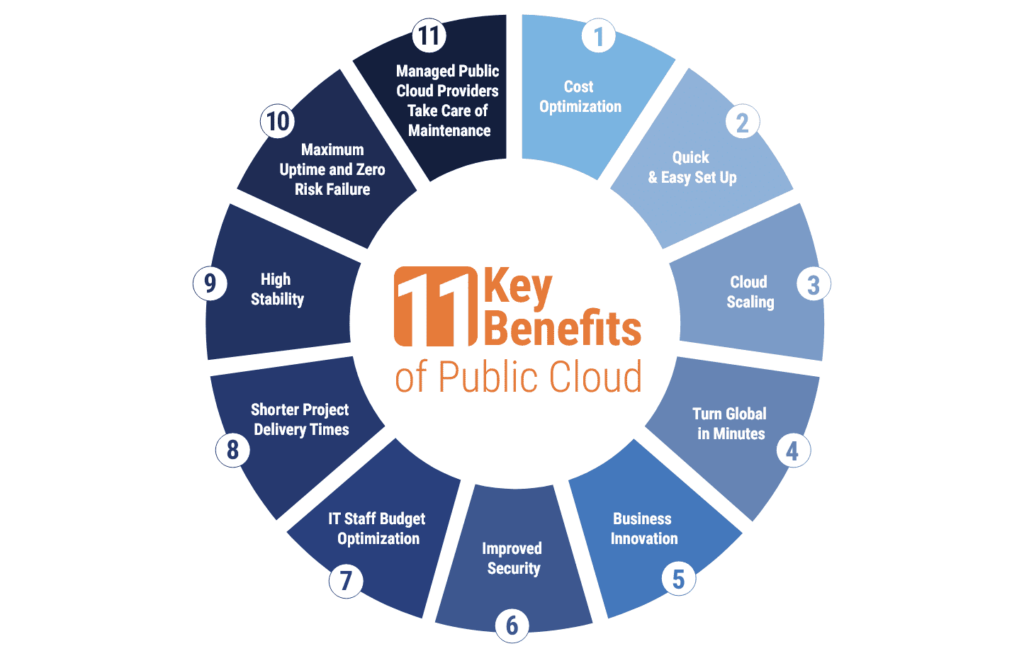
If you’re a medium to enterprise business that is growing, and you’re deciding on what technology infrastructure will best support your business, you may want to explore the benefits of public cloud. Whether you’re considering a transition from on-premises data centers or colocation to the cloud, or you’ve already initiated a cloud deployment, it’s essential to understand the benefits of public cloud.
What is Public Cloud?
A public cloud environment uses virtual machines and physical servers to keep a large, distributed computing environment running. No more paying for equipment, space, or utilities you don’t use. With public cloud services, you pay for what you need, when you need it.
Additionally, public cloud infrastructure allows organizations to scale quickly without worrying about paying extra for the aspects of physical infrastructure. A sudden or seasonal surge in demand from end users shouldn’t stall your business operations.
Some of the most popular public cloud service providers include Amazon Web Services (AWS), Microsoft Azure, Alibaba, and Google Cloud Platform (GCP).
Public Cloud vs Private Cloud
For organizations looking for added security and customization, utilizing the benefits of private cloud might be an attractive option. This can be a solution for organizations that have extremely sensitive information, such as health or financial data. It can also be fitting for organizations that require specific compliance measures that aren’t met by public cloud providers.
Why Companies Are Migrating to Public Cloud
Still, for many companies, the public cloud meets their requirements. Migrating to the public cloud has many benefits and can save money, allow for easy scalability, and provide greater reliability and security for both internal team members and end users than on-premises infrastructure.
11 Key Benefits of Public Cloud

Cost Optimization
Overhead can add up quickly, and one of the biggest benefits of moving your data to the public cloud is that you can add resources as needed to maximize your value and ensure cloud cost optimization without having to worry about:
- additional cooling
- power
- cabling
- maintenance
- capital expenses, like equipment upgrades and real estate management
Most public cloud providers also offer pay-as-you-go models for services.
Quick & Easy Set Up
Public cloud computing models aren’t only beneficial from a cost savings perspective – they’re efficient as well. Scalable cloud resources can be spun up quickly when demand is added to the system, say through a sudden surge in traffic from a promotion or seasonal surge. Massive storage capacity is even possible with large public cloud service providers.
Cloud Scaling
Along with saving time, cloud scaling can bring ease to your operations. With the public cloud, you can create nimble virtual machines that can grow and shrink, balance workloads, and save you from server-intensive computing.
Turn Global in Minutes
Closely related to scalability, the public cloud allows organizations to turn global in minutes. Providers offer resources that can expand your business into new markets with a few clicks.
Business Innovation
The public cloud can also serve a major role in helping businesses innovate. The resources, security, and flexibility available from public cloud providers can give organizations what they need to develop machine learning systems, mobile apps, and analysis frameworks that may have previously been out of reach.
Improved Security
While a private cloud can offer customized security solutions for businesses, most will have their needs met, and then some, by the security measures available through public cloud providers. Oftentimes, these security features go beyond what organizations have in on-premises frameworks and can include encrypting data at rest and in transit, infrastructure monitoring, multi-factor authentication, and compliance with common regulations like HIPAA and PCI-DSS.
IT Staff Budget Optimization
Is your staff’s time better spent managing cloud infrastructure, or could their time be allocated to efforts that grow your business? Offloading responsibilities to a public cloud provider opens your internal staff up to take on more strategic roles. The public cloud can also help fill skill gaps on your current team, without the need to hire more people.
Shorter Project Delivery Times
Instant access to infrastructure, automated workflows, continuous integration, and continuous delivery (CI/CD) available through the public cloud can all work to shorten project delivery times for a development team.
High Stability
What would happen to your operations if a disaster occurred – say, a power outage, or a ransomware attack? Moving legacy workloads to the cloud will help enable easier backup and disaster recovery options vs on premises, getting you back to business sooner. This is often the case with moving any on-premises applications or data to any cloud.
Maximum Uptime and Zero Risk Failure
Instead of relying on one data center, working with a public cloud provider means Your business can be connected to multiple data centers located in different regions. In the event one should fail, other data centers will be available for failover and can continue to provide services. Engineers are also on call and available 24/7, monitoring and maintaining infrastructure. Constant attention to the infrastructure can help prevent failures from happening in the first place.
Managed Public Cloud Providers Take Care of Maintenance
Working with a large managed public cloud provider striving to stay competitive also means you will enjoy regular updates and iterations on services. Prominent managed public cloud providers will also offer best-in-class services, such as top-tier protection for your sensitive data, up-to-date support for operating systems, a reliable internet connection, and may also allow penetration testing of vulnerabilities within specific operating guidelines.
Which Workloads Aren’t a Good Fit for the Public Cloud?
While you can tailor some things to fit your needs, the public cloud isn’t as customized as a private cloud configuration. There are workloads that will not work in the public cloud. Some examples are:
Workloads with Highly Specific Needs
If one of your workloads included a high level of customized configuration when it was set up, it may be hard to replicate in the public cloud.
Operations That Adhere to Predictable and Data Requirements
These requirements could include specific conditions you need to meet for residency and compliance.
Legacy Applications That Are Not Built to Run in the Public Cloud
The public cloud can be a cost-saver for many businesses, but if you have a legacy application that requires significant effort to move to the public cloud, the cost of migration may not be worth the effort, especially if the eventual plan is to migrate the legacy application.
Workloads That Require More Stringent Security Compliance
While public cloud providers are responsible for protecting their infrastructure and data, and major cloud platforms offer security services that go beyond this, organizations may need to take additional steps to meet compliance requirements specific to certain industries or types of data.
Choosing The Right Cloud Option That’s Right For Your Workloads
There are many benefits of public cloud and adopting a public cloud solution can streamline operations and boost efficiency to your organization. But is the public cloud right for all of your workloads? Choosing the right cloud option and evaluating them carefully can help put workloads in the right places, while having them run optimally. Read our eBook for guidance on available cloud options and choosing the best fit for an organization’s needs.

